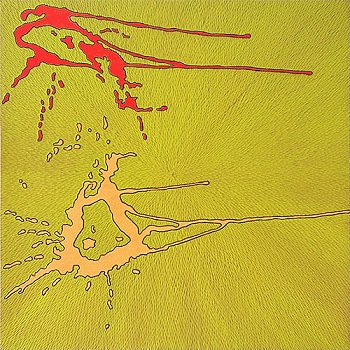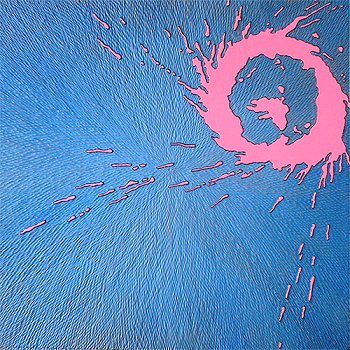



A Deeper Matrix:
Joe Thurston's Abstractions
a catalogue essay by Richard Speer
Catalogue sponsored by the Regional Arts & Culture Council
For a figurative painter, the journey into abstraction—whether in baby steps or by flying leap—can be harrowing. As I have written with regard to Mondrian: “Abstraction affords neither the luxury nor the distraction of subject matter; each brushstroke is no more and no less than a thought frozen on canvas.” [“Mondrian and Metonymy: The Soul of a Straight Line,” Final Cause, 1998] Yet, the turn to abstraction can also prove liberating, as has been the case with Portland, Oregon-based painter Joe Thurston. Well known as a portraitist in the métier of eccentric figuration, Thurston has recently abandoned the figure—or, perhaps more accurately, delved deeper into it, into realms undetectable to the naked eye, where distinctions between anatomy, microbiology, and gestural abstraction converge to stunning effect.
Thurston began painting and sculpting in his mid-teens. A breakthrough came at age 26, when he painted a green-tinted portrait of a friend, rendering the woman’s facial contours as if with the benefit of X-ray vision, effectively peering through her skin and exposing the musculature underneath. During the years that followed, this technique percolated, eventually evolving into the painter’s signature style: psychologically penetrating portraits of women in which the models’ defense mechanisms are stripped away along with their epidermises. It is a highly unusual, even unsettling style: psychotherapy sessions frozen on wood panel; a visual riff on the ugly-as-beautiful paradox identified by the French as jolie laide. As I opined in a May 2005 review [“Flaying Faces,” Willamette Week], “Thurston’s paintings are many things—confrontational, creepy, haunting—but one thing they aren’t, mercifully, is ‘pretty.’” Subsequently the artist experimented with intricately carved backgrounds, different angles of presentation, and framing devices inspired by Delacroix and Cezanne. His fans, collectors, and critics wondered where he would go next as he continued his variations on a theme: Would he begin painting men? Would he step back from the head-and-shoulders portrait and paint the entire figure?
No one could have predicted the development that steered Thurston away from his successful, tried-and-true style and into a new but related visual vocabulary with which he could articulate, as he puts it, “something more organic—not to sound too spiritual, but something in the deeper matrix of the world.” In the spring of 2004, Thurston hosted a friend from London, the artist Geoff Hautman. Hautman was familiar with printmaking techniques and, one evening in Thurston’s studio, gave the painter a quick printmaking tutorial, using a black paper napkin to illustrate a point. Thurston noted the information and filed it away mentally as he contemplated his next artistic move. The following year, recalling the exchange with Hautman, he began contacting manufacturers of linoleum block, a material used in certain methods of printmaking. Finding a satisfactory supplier he commenced making 6-by-6-inch abstract floral still lifes based on motifs from the Luttrell Psalter, a 14th Century illuminated manuscript, which the artist had viewed online. The coffee kept percolating. In his studio late one night in April 2006, he began drawing vine-like motifs onto the linoleum block, using a compass to dictate their placement on a circular continuum. The piece, which he later titled “It is These Pauses That are Our Undoing,” vaguely evoked Japanese throwing stars and fueled Thurston to develop his ideas further.
In his next work, “Silence Heaped Around,” he traded in the compass-imposed regularity and hand-drew a twisty, meandering motif. “It was like the curve in your wrist,” he says, “or like the fiddlehead ferns that grow all around my house.” He and his wife began to refer to the motif as “the squiggle,” a benign, whimsical moniker for something darker, something that evoked tendrils and tentacles, fungi, viruses, neurons, and cancers. By letting his wrist channel that sinuous gesture, Thurston was freezing a microcosmic moment in paint and friezing it in carved relief; finessing the line between beauty and ugliness in a different way than he had in his portraits, but finessing it still—for what could be more beautiful than a growing plant stretching toward the sun, and what more fearsome than a cancer growing toward its manifest destiny?
In Thurston’s next piece, “Oblivion Draws its Veil,” he carved his branching tendril into the panel, turned the composition on its side, dripped paint down its entirety, then outlined and carved the drips where they had run in rivulets through and around the central motif. This new tack—transliterating a painterly gesture into the carved medium—proved a critical step. In “Two Ways/One Time,” he flung paint onto a panel, then outlined and carved the splatters, integrating them with two concentric buzz-saw-like patterns: a striking integration of composition and random gestural event. Next he concretized this modus operandi by spinning hurricane-like whorls of paint in a spectacular gesture in the upper-right quadrant of a new work called “Our Own.” After outlining and carving this gesture into the block, he made a daring color choice, hot pink, mixing the pigments obsessively until the hue was just right. Juxtaposing this pink with cool cerulean, he effectively crowned what may be the most dramatic departure to date from his previous work: a fully realized superimposition of gestural abstraction onto the sculpturally carved panel. The piece, quite literally, is a masterstroke, recalling in its own way Roy Lichtenstein’s mid-1960s Brushstrokes series, in which the Pop artist riffed on Abstract Expressionism using his own native technique, the newsprint/cartoon pixel. Those works were wittily conceptual, simultaneously reverential of the past and self-referential of the artist’s distance from it, and so are Thurston’s. Brilliant mutations, ripe for infinite variation and future development, the works are sly, sophisticated, and above all exuberant. Further works demonstrate that the artist has only begun to mine the formal and expressive potential of this new style.
From my perspective as a critic who has followed Thurston’s work for four years now, I see this new vein as hyperspace jump. It has led this always fascinating artist toward unexpected new avenues: toward spontaneity, the joy of accident, the kinesthetic abandon of gesture, and a welcome buoyance in the aftermath of a weighty, years-long cataloguing of gender-specific psychodrama. It has afforded him the opportunity to accomplish all of the above via a jaw-dropping formal innovation: a stylistic synthesis of splatter painting and sculptural carving on wood panel. It will be intriguing to see whether Thurston guides these ideas further toward organicism, á la his curving tendrils; or toward pure abstraction, as in his splatter carvings; or, most intriguingly, in directions wholly unanticipatable even to the artist himself.
—A contributing critic to ARTnews and Art, Ltd., Richard Speer is the author of Matt Lamb: The Art of Success (John Wiley & Sons). He is visual arts critic at Willamette Week, the Pulitzer Prize-winning alternative weekly in Portland, Oregon, and has written about cultural matters for Newsweek, Salon, The Los Angeles Times, and Opera News.FOR MORE INFORMATION ABOUT JOE THURSTON,
VISIT WWW.JCTHURSTON.COM OR WWW.ELIZABETHLEACH.COMBACK TO CATALOGUE ESSAY MENU
BACK TO RICHARD'S WELCOME PAGE
BACK TO RICHARD'S RESUME